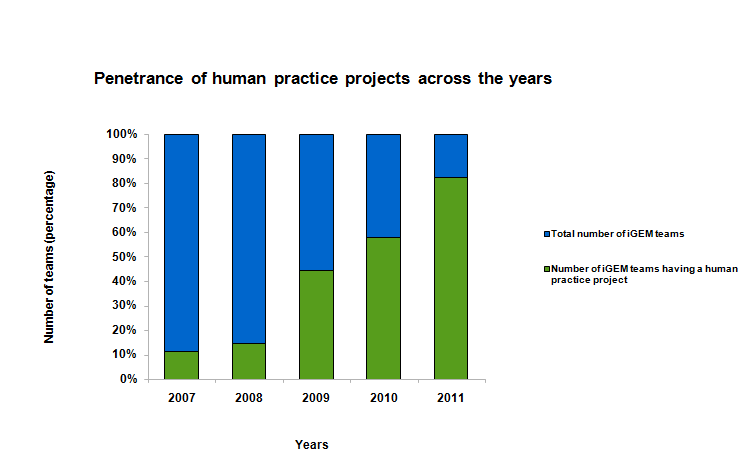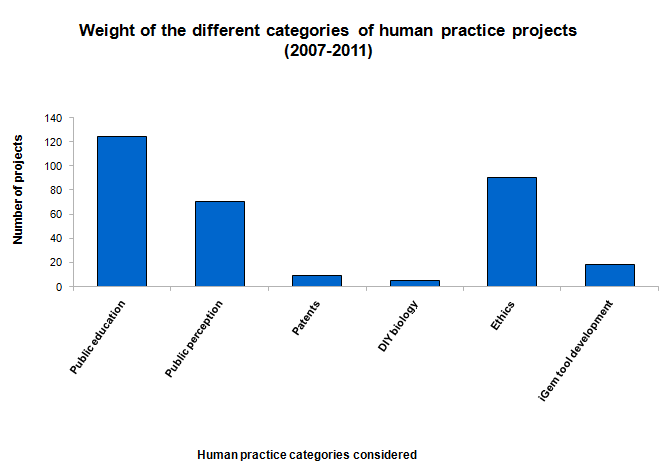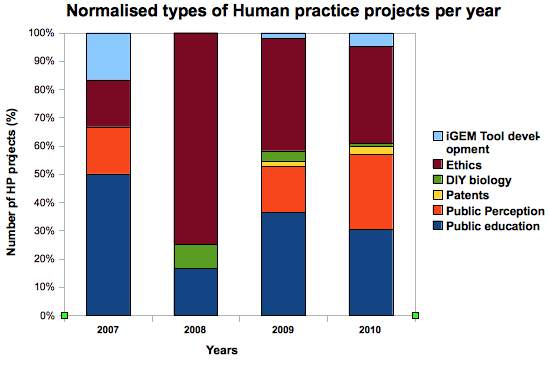Team:Paris Bettencourt/HumanPractice
From 2011.igem.org
(→Analysis of Data Scanned) |
(→Analysis of Data Scanned) |
||
| Line 40: | Line 40: | ||
[[File:Image_categories_HP.png|thumb|upright=3|center]] | [[File:Image_categories_HP.png|thumb|upright=3|center]] | ||
| + | |||
| + | The graph below shows the percentage of each category of human practice project in each year of the iGEM competition. As observed, a greater number of teams that worked on human practice project in the beginning (2007) focused on educating the public on the new field of synthetic biology. This has however decreased recently in 2010 since synthetic biology is growing in the community and the awareness is increasing. Now that the synthetic biology has become known to the public, the next hurdle is to look at the perception of the public on the field and this attributes to why an increase in human practice projects centred on public perception is observed in recent iGEM human practice projects. | ||
[[File:Picture_typehp_year.png|thumb|upright=3|center]] | [[File:Picture_typehp_year.png|thumb|upright=3|center]] | ||
Revision as of 02:52, 22 September 2011

Human Practice
Abstract
The grand scheme behind the Parisian Human Practice of this year is to synthetize questions and possibly answer some of the concerns or issues that previous iGEM might have had. While this exercize being done we expect that new questions/concerns might arise. Next, an outline of needs and responsibilities of either iGEMers, synthetic biologists or governmental bodies can be made. Using this final we hope to create a unified document: citizen and scientific proposal on synthetic biology.
The project
Introduction
Much like in the early times of Biotechnology scientists gathered and set for themselves some basic standards and practices on both ethical and pragmatic issues I believe that it is time we, iGEMers, as future researchers are entitled to have our word on how the field of synthetic biology (as well as the iGEM competition) ought to look like. Did you know that the President Obama asked last year for a report on bioethical issues regarding Synthetic Biology? The report came out in December 2010 and included a set of recommendations that the discussion panel deemed necessary. Good. Better yet: why not produce a more down-to-earth proposal on synthetic biology ?
As an interesting turn of fate 2012 happens to be the year in which both French and US Presidential elections are happening (and 2013 for the German ones), what if we could produce a unified document that could potentially change the face of how Science is done? Ambitious? Most probably BUT if we co-operate on European level such an aim is completely attainable. The first thing is to get the frame of analysis, have clear steps to follow if coordination is to happen.
Please find the outline I propose for the co-operative project for an iGEM centered proposal on synthetic biology.
The more we are, the more questions we can tackle! While this si targeted primarily towards European teams because we are operating under common basis (European Union regulations) the debates are similar across the world therefore everybody is welcome
Step 1: Scanning of the wiki
We dedicated a good deal of time just to actually go into each wikis of each years since 2007 until 2010 and find what were the themes tackled by the teams. A priori, we told ourselves that obviously teams having a clear human practice tab were to be considered but as in the past iGEM competition it was not mandatory to include such discussion we thought that people might have included it within a more general discussion and this is why we read all of them. Everytime there was a discussion about bio-safety/bio-security ethics or any kind of reflexion revolving around synthetic biology up to the application of the project was taken into account. The primary raw data was huge, but we already had quite an overview of what had been said. This is where we agreed between us to discard discussion on applications of a project since most teams where mentionning it. Second, we created six convenient categories that are as follows:
- Public education
- This includes bringing to the public (defined as other iGEM teams, scientists or the general public) a presentation of what is synthetic biology (SB) or the specific iGEM project may it be in the form of a forum, a conference or classes given to students.
- Public perception
- This includes getting to know the opinion or the preconception of what is SB, genetic modifications of organims and any relevant pieces of information about their knowledge in biology/modelling/engineering. We also included in that part the social and political framework in which iGEM evolves.
- Patents and licenses
- This is a rather specific discussion or questioning about laws, patenting regulations and other legal concerns.
- DIY bio
- The Do It Yourself (DIY) movement is at the cross-section of many societal and scientific debates therefore it is a section in and of itself.
- Ethics
- This is the most vague section as it includes bio-safety, bio-security issues as well as questioning about application and societal implications of iGEM and biology at large. As a matter of fact any thorough investigations and questioning revolving around SB was included here.
- iGEM tool development
- Some teams decided to give back to the SB's community in another form than BioBricks, some of them developed "how-to" guides and others software programs.
Analysis of Data Scanned
This way of regrouping common questions, common practices mentioned by the past teams allows for some basic statistical analysis. What we present here is mostly for descriptive purposes. The first trend that we observe is an obvious augmentation of human practice (HP) projects, both in terms of absolute numbers and relatively to the number of iGEM projects, over the years.
Second, we have this other simple bar graph that is an overview of the data obtained from the scan. It gives the relative amount of each kind of category. Interestingly, "Ethics" with 38% of teams treating it has been the most widely discussed theme. Right after comes "Public Education" (32%) and "Public Perception" (21%). The three remaining themes account for the rest (9%). It must be noted that we might at some point considered two different themes for a single team if their projects covered them so this makes a greater total number of themes than human practice projects per se.
The graph below shows the percentage of each category of human practice project in each year of the iGEM competition. As observed, a greater number of teams that worked on human practice project in the beginning (2007) focused on educating the public on the new field of synthetic biology. This has however decreased recently in 2010 since synthetic biology is growing in the community and the awareness is increasing. Now that the synthetic biology has become known to the public, the next hurdle is to look at the perception of the public on the field and this attributes to why an increase in human practice projects centred on public perception is observed in recent iGEM human practice projects.
Analysis of the Grenoble Video
 "
"



